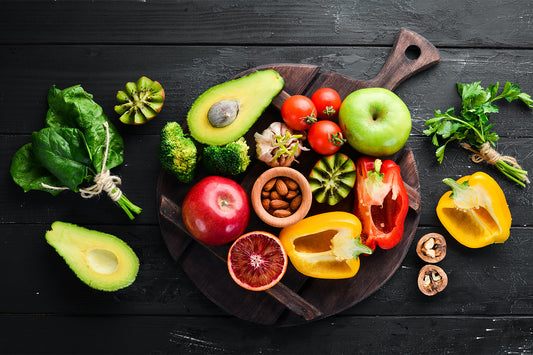When you hear the term “dietary fat,” it may bring up mixed emotions. After all, many people argue that you should avoid eating fats at all costs, while there is also plenty of support from the medical community saying that fats are heart-healthy and good for you. So what’s the truth?
Dietary intake of fats plays multiple important roles in the body, from making up the construction of cells in the body to supporting the healthy function of several bodily systems. However, several types of fats are found in food, and some are less healthy or beneficial than others. Some foods contain a mix of different fats, meaning you have to be extra mindful about your meals.
By breaking down the different types of fats and where you can find them in your diet, you can determine how to balance your diet with only the healthiest fats for the most potential health benefits.
What Are Saturated Fats?
Saturated fats are fats that are usually solid at room temperature. Saturated fats have a reputation for harming your health, as they can increase your risk of heart disease and obesity, among other complications. With such a negative reputation, not eating too much saturated fat is a good idea.
The American Heart Association recommends getting no more than 5 to 6% of your daily calories from saturated fat. To break that down mathematically, if you eat 2,000 calories a day, then foods with saturated fat shouldn’t be more than 120 calories.
Examples of saturated fats include:
- Red meat
- Lard
- Full-fat dairy
- Cheese, yogurt, or ice cream made with whole milk
- Coconut or palm oils
Even if you are not consuming these foods directly, saturated fats may still be a part of your diet. For example, if you eat a meal that is cooked using saturated fats like butter or lard, you are still consuming saturated fats. Foods like burritos and burgers that combine sources of saturated fat can add up quickly, and baked goods are another common culprit of stacking up sneaky saturated fats.
What Are Unsaturated Fats?

Unsaturated fats are a type of fat that is liquid at room temperature. These fats are often referred to as “good fats” because they offer a range of potential health benefits. Some of the potential benefits of unsaturated fats include supporting blood cholesterol levels already within the healthy range, supporting healthy heart function, and supporting cognitive health, among many others.
There are two main types of unsaturated fats that differ only in how their chemical structure is formed — although each type of unsaturated fat has its own common food sources, some foods contain both types.
Monounsaturated Fats
Monounsaturated fats are one of the two main types of these fats, and they are distinguished by the fact that they have a single carbon bond in their chemical structure. Monounsaturated fats can offer several potential health benefits, like supporting heart health, promoting healthy blood sugar, and maintaining triglyceride (aka fat) levels already within the normal range.
Sources of monounsaturated fats include:
- Plant oils like canola oil, peanut oil, and olive oil
- Avocados
- Pumpkin seeds
- Sesame seeds
- Sunflower seeds
- Almonds
- Peanuts and peanut butter
Monounsaturated fats are also found in some foods that contain saturated fats, like red meat and dairy products. To see the most benefits, you should consume monounsaturated fats from plant sources when possible.
Polyunsaturated Fats
Polyunsaturated fats are like monounsaturated fats, except their chemical structure has a double bond of carbon. The most common examples of polyunsaturated fats are omega-3 fatty acids and omega-6 fatty acids.
This can be broken down further when we look at the three types of omega-3, which are alpha-linolenic acid (ALA), docosahexaenoic acid (DHA), and eicosapentaenoic acid (EPA). Each of these types of omega-3 features multiple potential health benefits, but the most beneficial are DHA and EPA. These polyunsaturated fats can help support heart health, support healthy joints, promote healthy cognitive function, and more.
You can find polyunsaturated fats in the following foods:
- Plant oils like canola oil, corn oil, soybean oil, sunflower oil, and flaxseed oil
- Chia seeds
- Flax seeds
- Fish
- Soybeans
- Walnuts
What Are Trans Fats?
Trans fats are a type of unsaturated fat, and they are one of the most prominent forms of fat in a standard diet. Trans fats are formed by heating up vegetable oils in a process called hydrogenation.
Partially hydrogenated oils are often turned into a solid, like margarine or shortening. These oils are often used for frying fast foods, making baked goods, and processing snack foods. As a result, these foods are the highest sources of trans fats. However, trans fats can also be found naturally in beef and dairy fat.
Trans fats are the worst form of fat in our diets as they can have many negative health impacts, especially when we eat a lot of them. These unhealthy fats can increase the risk of cardiovascular disease, cause inflammation in the body, and raise bad cholesterol levels. Therefore, you should aim to avoid or minimize trans fats as much as possible.
How Are Cholesterol and Fats Related?
When discussing fats, cholesterol is an important factor in the conversation. After all, the fats you consume in your diet can directly impact your cholesterol levels. Cholesterol is a waxy substance produced by your liver and transported through the blood. There are two types of cholesterol — high-density lipoprotein (HDL) and low-density lipoprotein (LDL).
LDL cholesterol is often referred to as bad cholesterol because it can bind with fats in your blood called triglycerides. By binding with these fats, LDL cholesterol can build up in your arteries, causing blockages that can lead to more serious heart health issues. Meanwhile, HDL is considered good cholesterol because it helps carry the bad cholesterol to the liver, where it can be removed from the bloodstream instead of building up in your arteries.
All that said, higher LDL cholesterol levels are “bad,” while higher HDL cholesterol levels are “good.” By eating more healthy fats and less saturated or trans fats in your diet, you can maintain a healthy balance of these two types. In doing so, you avoid building up excessive triglyceride levels in the blood and support cardiovascular health.
Polyunsaturated fats like omega-3s are known for their potential to help maintain cholesterol levels already within a healthy range and support healthy blood pressure.
How Do You Consume More Healthy Fats?
To consume more healthy fats, you should include more nutrient-rich whole foods and avoid processed or heavily fried foods. You can also include more healthy fats in your diet by consuming more of your fats from plants than animals. Avoiding animal foods like beef and dairy can allow you to skip out on unhealthy saturated fats and traces of trans fats.
Other healthy habits to think about include:
- Using plant oils for cooking instead of butter
- Checking labels of snacks for saturated or trans fats
- Opting for low-fat products that don’t include high amounts of sugar
- Including more marine foods in your diet
Can You Supplement Healthy Fats?

You should maintain a balanced diet that allows you to consume healthy fats directly from food sources. However, that is easier said than done for some fats. Therefore, supplements can provide you with the ability to consume more healthy fats that are harder to come by.
For example, omega-3 polyunsaturated fatty acids can be found in a range of plant foods. However, there are three different types of omega-3s you should include in a healthy diet. Even if you consume ALA omega-3s, you should still consume DHA and EPA from dietary sources as well, as they offer superior benefits to ALA alone.
However, consuming DHA and EPA can be a challenge since the only common dietary source is fatty fish or omega-3 supplements. Not to mention, many people aren’t able to eat fish due to dietary choices or allergies.
Fortunately, you can get these two essential fatty acids from algae instead. Algae is a marine plant that is rich in DHA and EPA fatty acids. Algae is a regular component of the diet of fatty fish, meaning that fish don’t produce omega-3s themselves. So when you obtain your essential omega-3 fats from algae, you can get them directly from the source and eliminate the middleman — or fish — altogether.
iwi lifegives you the opportunity to consume algae in the form of a daily plant-based omega-3 supplement. Just one softgel gives you a combined 250 mg of EPA and DHA, giving you all you need to start supporting your overall health and wellness — without any fishy aftertastes.
Include More Healthy Fats in Your Diet With iwi life
Despite all the mixed information surrounding dietary fat, the truth is that you just need to know which fats to include. By avoiding saturated and trans fats in your diet and adding unsaturated fats like omega-3s, you can start to support your heart health.
You can start the path to increasing your healthy fat intake with iwi life. Our omega-3 supplement gives you two essential fatty acids without the downsides of other fat sources. Explore iwi life’s complete family of algae-based omega-3 supplements so you can see all the ways that healthy fats can support your well-being.
Sources:
Types of Fat | The Nutrition Source | Harvard T.H. Chan School of Public Health
What is Cholesterol? | American Heart Association



















